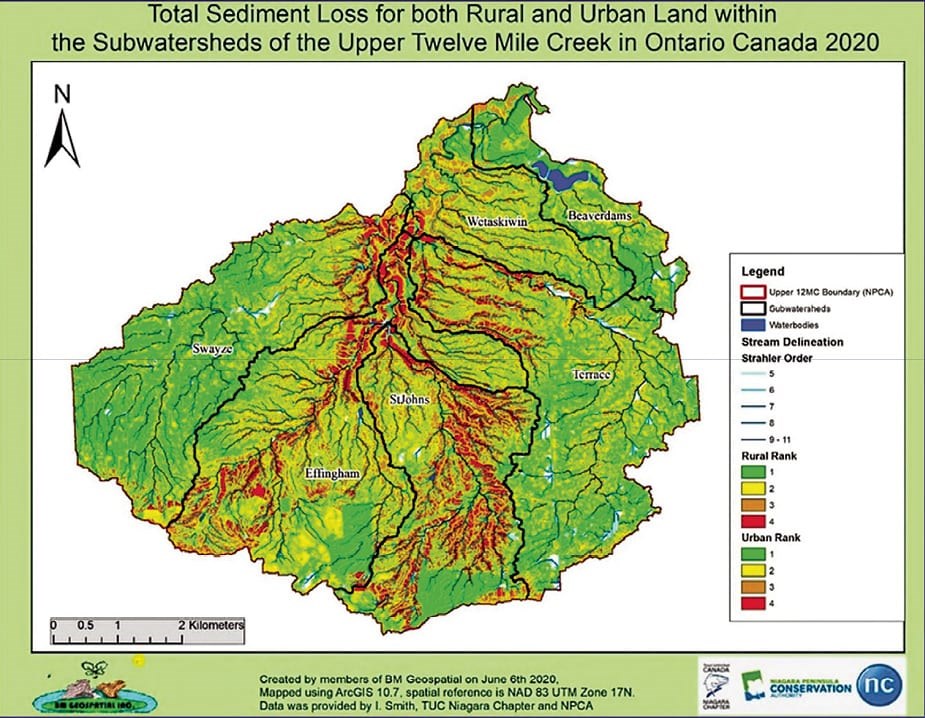Pelham mayor pleads for action, not further studies
Several senior members of Pelham Town staff along with Mayor Marvin Junkin took part in a video-conference meeting of Twelve Mile Creek stakeholders on September 30, with the aim to get consensus on “protecting and restoring the creek and its watershed.”
Planning and Development Director Barb Weins and Public Works Director Jason Marr joined the Mayor for the 90-minute online session, organized by the Niagara Chapter of Trout Unlimited Canada (TUC). Their participation was deemed critical since the source of two of the most significant branches of Twelve Mile Creek are found in Fonthill. Though invited, no Pelham Town Councillors attended.
In his introductory remarks, Dennis Edell, the president of the chapter, spoke about the significance of Twelve Mile Creek, “the last remaining spring fed cold water stream in Niagara with a population of native Brook Trout.”
The most fragile of the trout species, said Edell, these fish are the best indicator of a healthy watershed. Once populous in the Twelve, they have now retreated to a few pockets of clear, cold water.
“As things are going,” he said, “without help from all of us here today, Brook Trout habitat will continue to degrade and another species will disappear from Niagara.”
The meeting was attended by a broad cross section of staff and politicians from Pelham, Thorold, and St. Catharines, jurisdictions through whose territory Twelve Mile Creek meanders on its way to Lake Ontario. The Niagara Peninsula Conservation Authority (NPCA) was well represented, as was the Niagara Region, with several senior planners and Pelham’s Regional Councilor, Diana Huson, present along with executive members of the Niagara Chapter of TUC, and CAO of the organization, Silvia D’Amelio, from Calgary.
Without help from all of us here today, Brook Trout habitat will continue to degrade and another species will disappear from Niagara
Speaker Jack Imhof, an internationally respected expert on stream renewal who has contributed to dozens of restoration projects across Canada, set the scene by emphasizing that the health of our watersheds is integral to the health of our land, and directly impacts human health. Based on his experience, an integrated approach to helping a severely damaged stream is essential—involving landowners, municipal governments, scientists, and NGOs like Trout Unlimited.
A senior planner with the Niagara Region, Shawn Norman, followed with an outline of the Region’s current initiative to develop a comprehensive watershed plan which would include Twelve Mile Creek and eventually become part of the new Niagara Official Plan.
Professor Ian Smith, who both teaches environmental studies at Niagara College and is a professional stream restoration specialist, brought the focus to the local level with a thorough analysis of the current, urgent situation of Upper Twelve Mile Creek, echoing Edell’s words that, “Brook Trout are the best indicator we have of a healthy watershed and their decline is a clear warning sign that the watershed is sick.”
Using research generated by his students and his own monitors, Smith revealed that some thirteen million kilograms (13,000 metric tonnes, or about 1000 large dump trucks) of sediment clog the watershed annually. Much of this, he maintained, is the result of development upstream that increases runoff by, as he put it, “paving paradise to put up a parking lot, to quote Joni Mitchell.”

Smith also pointed to increased water temperatures caused by deforestation, online ponds, maintenance practices such as mowing to the edge of the stream, and global warming. Several of his illustrations targeted the dramatic erosion caused by the outflow from the East Fonthill storm water management pond on Highway 20, which is meant to mitigate runoff due to the East Fonthill development.
In one storm, Smith measured 70 centimetres of erosion adjacent to the Pelham Cares building caused by the outflow. He also focused on the issue of Sulphur Springs Road and the damage caused by poor design and overuse of the road, as well as increased flows during storms, leading to catastrophic failure that potentially could cost the Town many hundreds of thousands of dollars.
While development was fingered as the culprit in many of the serious issues facing the stream, the CAO of Trout Unlimited Canada, Silvia D’Amelio, joined the discussion to point out that development and stream preservation can be compatible. She agreed with Jack Imhof in saying that municipalities can and should insist that developers include measures to limit runoff and mitigate the damage their buildings cause to groundwater, streams, and rivers. If these rules are made clear and efficient, the developers themselves prefer a streamlined, clear, and coherent set of regulations they must follow. The concept of “Low Impact Development Strategies” (LIDS) has been incorporated into the regulatory framework for development in several southern Ontario jurisdictions, including Toronto, Hamilton, Credit Valley, and London.
The NPCA has a major role to play in any attempt to improve and protect Twelve Mile Creek and Geoff Verkade, Senior Manager, Integrated Watershed Planning & Information for the Conservation Authority, outlined the watershed plans that have been developed and updated previously, and suggested these can form the basis for a comprehensive strategy for future protection of the creek. He welcomed the Niagara Chapter TUC initiative in bringing interested parties together and pledged to continue to work as a partner with the Chapter.
During the question period, Mayor Junkin pleaded for action rather than more studies and promised to work with Town staff to investigate issues where they can make improvements, including the outflow from the Highway 20 storm water management pond.
Dennis Edell concluded with his thanks to the more than 40 participants. With such a broad base of significant stakeholders showing interest in the preservation and restoration of the watershed, he said he feels confident that future sessions can lead to real change in the way Twelve Mile Creek is treated. In a follow-up email, he promised, “Our next meeting will be more interactive with discussion about next steps and action items.”


